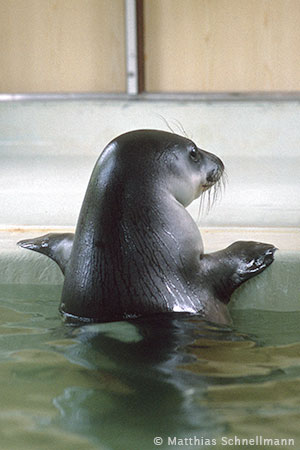
On 20 November we posted a “Pop Quiz” to draw attention to some of the explanations (many of them fanciful, it has to be said) that have been offered over the years for the origins of the monk seal’s name. To the question “How did the Monk Seal Find its Name?” the multiple choice answers were:
(1) Because the black seal with the white belly patch was reminiscent of the robes of a monastic community.
(2) Because the monk seal is shy and retiring, living a “monastic” lifestyle.
(3) Because of the folds of fat around the neck of the seal were reminiscent of a monk’s hood or scapular.
(4) Because the rows of seals stretched out lazily on the sands reminded Roman naturalist Pliny the Elder of a procession of hooded monks.
(5) None of the above.
The answer, we can now reveal, is: (5) None of the above.
The name ‘Monk’ seal was suggested by Johann Hermann in 1779, when the naturalist published the first modern scientific description of the species based on observations of a captive specimen found in a travelling show in Strasbourg. Hermann suggested naming the animal Münchs-Robbe (Phoca monachus), because he somewhat vaguely remembered a paper describing an animal known locally as moine in Marseille, which he concluded must be this same species. He was also reassured by contacts who had lived in Marseille that the animal was indeed called moine there. Wryly noting a monkish resemblance (the shape of the head and scapula-like shoulders) as the seal arched up on the pool edge, he judged it a well suited name, and saw no reason to change it.
Herman wrote (in German): “In this posture, it looked from the rear not dissimilar to a black monk, in the way that its smooth round head resembled a human head covered by a hood, and its shoulders, with the short, outstretched feet, imagined like two elbows protruding from a scapular, from which a long, unfolded, black robe flows down.”
Thomas Pennant, citing Herman as his source, mistranslated this in his History of Quadrupeds, Vol. 2, 1781: “When the animal is placed on its back, the skin of the neck folds like a monk’s hood.” This erroneous translation is most probably the source of the often repeated explanation (even by present-day biologists) that folds of fat observed around the neck are reminiscent of a monk’s hood — thus inspiring the name.
In Hermann’s day, the monk seal was also known by different colloquial names according to region and locale, for example simply as fokia in Greece, but elsewhere, amongst other variations, as sea bear, sea calf, sea dog, sea oxen and sea wolf. In his description of the monk seal, Hermann admits that he could not find the source of his recollection that the animal was known locally as moine in Marseille. A lead though, supporting Herman’s assumption that they are one and the same species, comes from the 19th century Dalmatian naturalist Spiro Brusina, who reported that Italian fishers knew it as monaco marino, the marine monk. Likewise, on the Dalmatian island of Vis, the popular name for the seal was morski fratar, the Sea Friar.
As to the reasons why the seal was named locally moine, monaco marino or morski fratar, we can currently only speculate (see Monk Seals in Post-Classical History, below, for further possible deductions). Perhaps some linguistic and cultural research might shed further light on that particular aspect of the puzzle. So far, although frequently reported, the historical record has not revealed any firm evidence linking the monk’s name to a solitary or ‘monastic’ lifestyle.
For further details see
Our illustrated two-volume “Monk Seal Histories”, Monk Seals in Antiquity and Monk Seals in Post-Classical History, available here in PDF format.
For those familiar with German, the original description of the monk seal by Johann Hermann is available online: Beschreibung der Münchs-Robbe, in Beschäftigungen der Berlinischen Gesellschaft Naturforschender Freunde 4 (XIX), 1779.
